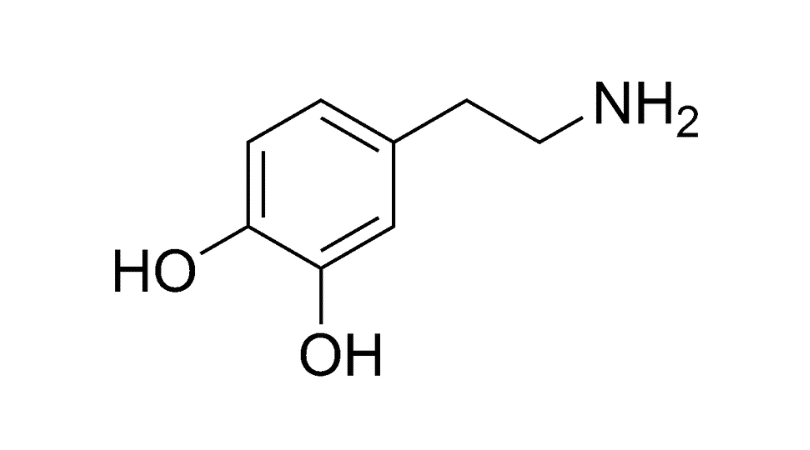
Dopamine is a kind of neurotransmitter made by the body and regulated by nerve cells for transmitting and receiving messages. Since dopamine is involved in sending and receiving messages, it is often referred to as chemical messengers.[1]
Dopamine also has a vital role in determining pleasure. However, the use of dopamine goes beyond this. For instance, did you know that it is associated with the capacity of thinking and planning? If you haven’t been able to plan and focus properly, it is mostly because your dopamine levels are decreasing. But, dopamine has a vital role in determining your hard work, hustle, and attention.[2]
Dopamine levels are spread in different pathways. The excess or lack of dopamine levels isn’t noticed in the body until a problem is detected.[3]
Like everything else, too much or too little of anything can be very harmful. Similarly, too much or too little dopamine can be harmful and may backfire. It is for this reason that the experts ask to keep a check with the dopamine levels. Often the fluctuating levels of dopamine can give way to different health conditions such as Parkinson’s disease. However, other illnesses caused by fluctuating levels of dopamine may not have that severe impact.[4]
Without dopamine, you wouldn’t be much of a human. It is the only chemical responsible for the binding of all the interpersonal relationships and actions you take.
The impact of dopamine on the brain is dependent on different factors. Over the years, some argued that dopamine is responsible for the feeling of pleasure. Scientists, though, now believe that dopamine is responsible for motivation and anticipatory pleasure.
How is dopamine made within the brain?
There is a progressive two-step process for dopamine production in the brain. Initially, amino acid tyrosine is transformed into dopa and then to dopamine.
Dopamine is responsible for influences on your physical changes and behavior. Some of the prominent aspects affected by dopamine include the following.[5]
- Learning
- Lactation
- Sleep
- Mood attention
- Movement
- Nausea and vomiting control
- Heart rate
- Motivation
- Kidney function
- Pain processing
Role in mental health
Mental health disorders are challenging. Interestingly though, mental health is often associated with the level of dopamine. Some of the prominent disorders happen because of too much or less dopamine, like below.[6]
Schizophrenia: Researchers have shown that schizophrenia is related to a hyperactive dopamine system. The presence of excess chemicals may make you experience hallucinations and delusions. Also, you may feel a lack of desire and motivation.
Drug abuse and addiction: Drugs such as cocaine can increase the dopamine level in your brain. Although it can satisfy your needs, repeated use of dopamine will eventually be harmful. Once you become used to getting high, your body will not produce dopamine. As a result, you would feel emotionally low even when you’re sober.[7]
Dopamine in diseases
Dopamine is not only related to mental but also physical health. Did you know that obesity and Parkinson’s disease are related to dopamine?
Parkinson’s disease: The chemical imbalance of hormones due to Parkinson’s disease can boost a lot of physical symptoms such as poor balance, tremors, and coordination and stiffness. Since dopamine levels become less in Parkison’s disease, the doctors make sure to use medicines to boost the level.[8]
Obesity: If you eat more than you burn, you are bound to gain weight. Sure, obese people can lower their consumption and reduce weight. But is it that easy? No. Not having sufficient food can easily hamper the satisfaction level. If you do not consume enough good, the body won’t release sufficient dopamine levels and, eventually, serotonin.
Can dopamine save lives?
As suggested, dopamine is not only necessary for mental health but physical health as well. It may not be that effective, but in some cases, dopamine can be a total lifesaver that needs to be taken care of. The doctors may even prescribe artificial dopamine (inotropin) to treat different conditions such as cardiovascular problems, low blood pressure, septic shock, and poor blood flow.
Dopamine drugs, even when taken into supervision, need to be controlled as it can cause a lot of problems such as fast heartbeat, chest pain, irregular heartbeat, headache, nausea, vomiting, and trouble in breathing.[9]
How do I boost dopamine levels naturally?
Boosting dopamine levels naturally, isn’t as hard as you would think. If you follow a proper lifestyle and diet, your dopamine levels would be boosted instantly.
Eat lots of protein
Proteins are made of amino acids. Tyrosine is an amino acid too responsible for dopamine production. Consuming enough proteins increases the chances of dopamine production.[10]
Tyrosine is found in protein-rich foods such as turkey, beef, soy, dairy, and legumes. Make sure to consume these in enough amounts to increase dopamine levels.
Consume probiotics
Recent researches have shown a connection between gut and brain. The gut is often referred to as the second brain. Hence, the bacterias present in the gut can also produce enough dopamine that can help to boost mood and behavior.[11]
However, more research needs to be done to determine the connection between gut health, probiotics, and mood.
Exercise
If you want to boost your mood and increase endorphin levels in your body, regularly exercising can be a great help. This further helps to bring a change in dopamine levels.
Dopamine is one of the most required chemicals by the body. It is responsible for a lot of body movements. A balanced diet, a healthy lifestyle, and proper sleep can play an essential role in boosting dopamine levels for the body.[12]
[1] https://www.ncbi.nlm.nih.gov/books/NBK535451/
[2] Bhatt-Mehta V, Nahata MC. Dopamine and dobutamine in pediatric therapy. Pharmacotherapy. 1989;9(5):303-14. [PubMed]
[3] https://www.ncbi.nlm.nih.gov/pmc/articles/PMC4567218/
[4] Snyder SH. What dopamine does in the brain. Proc. Natl. Acad. Sci. U.S.A. 2011 Nov 22;108(47):18869-71. [PMC free article] [PubMed]
[5] https://pubmed.ncbi.nlm.nih.gov/30446950/
[6] Sibley DR, Monsma FJ, Shen Y. Molecular neurobiology of dopaminergic receptors. Int. Rev. Neurobiol. 1993;35:391-415. [PubMed]
[7] https://pubmed.ncbi.nlm.nih.gov/9025098/
[8] David C, Fishburn CS, Monsma FJ, Sibley DR, Fuchs S. Synthesis and processing of D2 dopamine receptors. Biochemistry. 1993 Aug 17;32(32):8179-83. [PubMed]
[9] https://www.ncbi.nlm.nih.gov/pmc/articles/PMC4684895/
[10] Meiser J, Weindl D, Hiller K. Complexity of dopamine metabolism. Cell Commun. Signal. 2013 May 17;11(1):34. [PMC free article] [PubMed]
[11] https://www.ncbi.nlm.nih.gov/pmc/articles/PMC5985548/
[12] Mills A. Dopamine: from Cinderella to Holy Grail. Trends Pharmacol. Sci. 1992 Nov;13(11):399-400. [PubMed]

